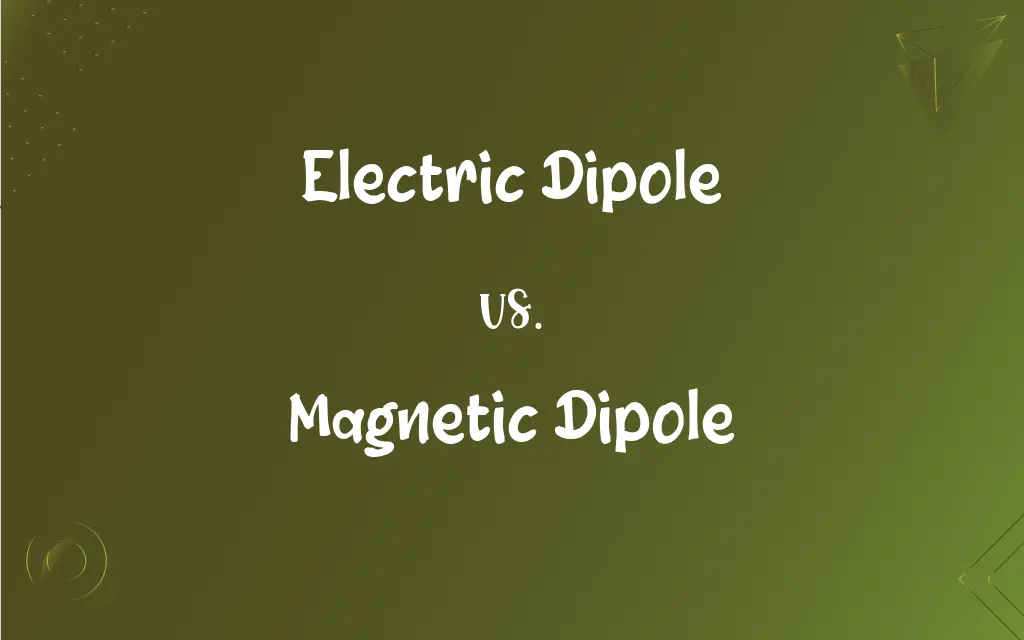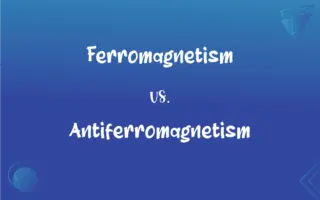Electric Dipole vs. Magnetic Dipole: What's the Difference?
Edited by Aimie Carlson || By Janet White || Published on January 15, 2024
An electric dipole consists of two equal and opposite electric charges separated by a distance, while a magnetic dipole is formed by moving electric charges, like a current loop or bar magnet.

Key Differences
An electric dipole is characterized by two equal but opposite charges separated by a small distance, creating a measure of the system's overall polarity. A magnetic dipole, conversely, is created by moving electric charges, such as electrons circulating in a current loop.
In an electric dipole, the dipole moment points from the negative to the positive charge and is a vector quantity. In a magnetic dipole, the moment is determined by the current and the area of the loop, often represented by the direction of a bar magnet's north pole.
Electric dipoles are fundamental in understanding molecular polarity and the behavior of materials in electric fields. Magnetic dipoles are key to understanding how materials behave in magnetic fields and are the basis of many electromagnetic phenomena.
The potential energy of an electric dipole depends on its orientation in an external electric field. Similarly, the energy of a magnetic dipole depends on its orientation with respect to an external magnetic field.
Electric dipoles are essential in the study of dielectrics and electrostatics, affecting phenomena like polarization. Magnetic dipoles are central to concepts in magnetostatics and are integral to technologies like MRI and electric motors.
ADVERTISEMENT
Comparison Chart
Composition
Two opposite charges separated by distance
Moving electric charges or current loops
Dipole Moment
From negative to positive charge
Determined by current and loop area
Field Lines
Emanate from positive to negative charge
Circular, surrounding the dipole
Role in Physics
Crucial in electrostatics and polarization
Central in magnetostatics and electromagnetic applications
Examples
Water molecule, polar molecules
Earth's magnetic field, bar magnets
ADVERTISEMENT
Electric Dipole and Magnetic Dipole Definitions
Electric Dipole
An electric dipole is a pair of equal and opposite charges separated by a distance.
The water molecule, with its asymmetrical charge distribution, acts as an electric dipole.
Magnetic Dipole
Magnetic dipoles are central in magnetism and electromagnetic theories.
Magnetic dipoles in atoms contribute to the overall magnetism of materials.
Electric Dipole
Electric dipoles affect the polarization in dielectric materials.
Polarization in dielectrics is often due to the alignment of electric dipoles.
Magnetic Dipole
Magnetic dipoles have a magnetic moment, indicative of their strength and orientation.
A compass needle aligns itself along the Earth's magnetic dipole moment.
Electric Dipole
Electric dipoles influence electrostatic potential and field distribution.
The electric field around a dipole is strongest near the charges and diminishes with distance.
Magnetic Dipole
Magnetic dipoles interact with magnetic fields, affecting their orientation.
A bar magnet in a magnetic field will align according to the field's direction, demonstrating magnetic dipole behavior.
Electric Dipole
Electric dipoles have a dipole moment, a measure of their polarity.
The dipole moment of a molecule determines its interaction with electric fields.
Magnetic Dipole
Magnetic dipoles are used in technologies like MRI and electric motors.
In an MRI machine, magnetic dipoles in the body align with the strong magnetic field, aiding in imaging.
Electric Dipole
Electric dipoles are fundamental in understanding molecular interactions.
In a uniform electric field, an electric dipole aligns with the field lines.
Magnetic Dipole
A magnetic dipole is a closed circulation of electric current or equivalent.
The Earth behaves as a giant magnetic dipole with a field resembling a bar magnet.
FAQs
What is a magnetic dipole?
A magnetic dipole is formed by moving electric charges or current loops.
How is the dipole moment of an electric dipole defined?
It's a vector pointing from the negative to the positive charge.
Can electric dipoles exist in atoms?
Yes, atomic and molecular dipoles arise from charge distributions.
What is an example of an electric dipole in nature?
Water molecules, with their uneven charge distribution.
How do magnetic dipoles interact with magnetic fields?
They tend to align with the magnetic field direction.
Is the strength of a magnetic dipole variable?
Yes, it varies with the current strength and loop size.
What is an electric dipole?
An electric dipole consists of two equal and opposite electric charges separated by a small distance.
What is a natural example of a magnetic dipole?
The Earth's magnetic field, resembling a bar magnet.
What determines the magnetic dipole moment?
It's determined by the current and area of the current loop.
What role do magnetic dipoles play in electronic devices?
They are key in the functioning of devices like hard drives and speakers.
Do electric dipoles have a field associated with them?
Yes, they create an electric field around them.
Are magnetic dipoles present in atoms?
Yes, atomic magnetic dipoles arise from electron spin and orbit.
How do electric dipoles interact with electric fields?
They align with the field, affecting the material's polarization.
How does the electric dipole moment affect molecular properties?
It influences molecular interactions and chemical properties.
How does temperature affect electric dipoles?
Higher temperatures can increase dipole movement and alignment.
Are magnetic dipoles affected by temperature?
Yes, temperature can affect magnetic alignment and strength.
Can the strength of an electric dipole change?
Yes, depending on the charge magnitude and separation distance.
Do magnetic dipoles generate a field?
Yes, they generate a magnetic field around them.
Can electric dipoles be artificially created?
Yes, they can be created in lab settings with charged particles.
Can magnetic dipoles be artificially generated?
Yes, using electromagnets or electric currents in coils.
About Author
Written by
Janet WhiteJanet White has been an esteemed writer and blogger for Difference Wiki. Holding a Master's degree in Science and Medical Journalism from the prestigious Boston University, she has consistently demonstrated her expertise and passion for her field. When she's not immersed in her work, Janet relishes her time exercising, delving into a good book, and cherishing moments with friends and family.
Edited by
Aimie CarlsonAimie Carlson, holding a master's degree in English literature, is a fervent English language enthusiast. She lends her writing talents to Difference Wiki, a prominent website that specializes in comparisons, offering readers insightful analyses that both captivate and inform.






































































